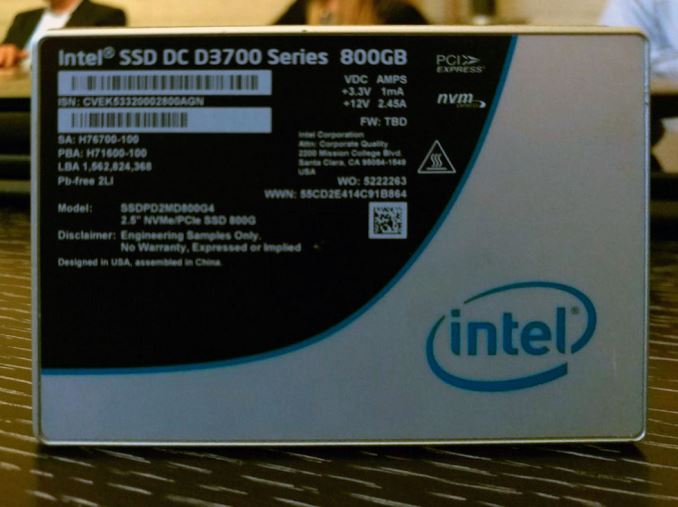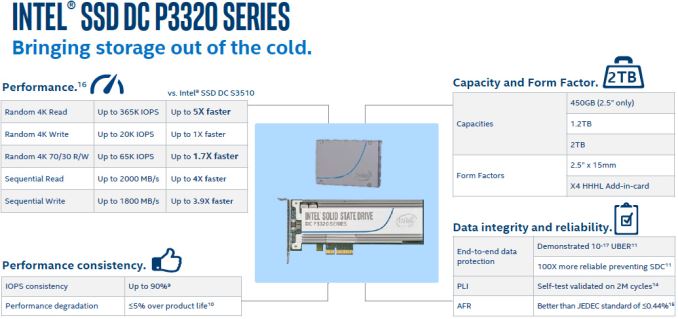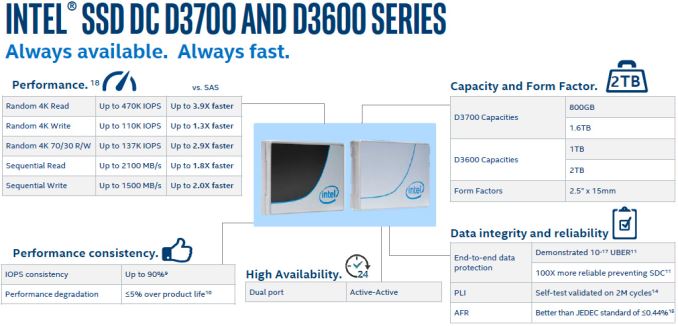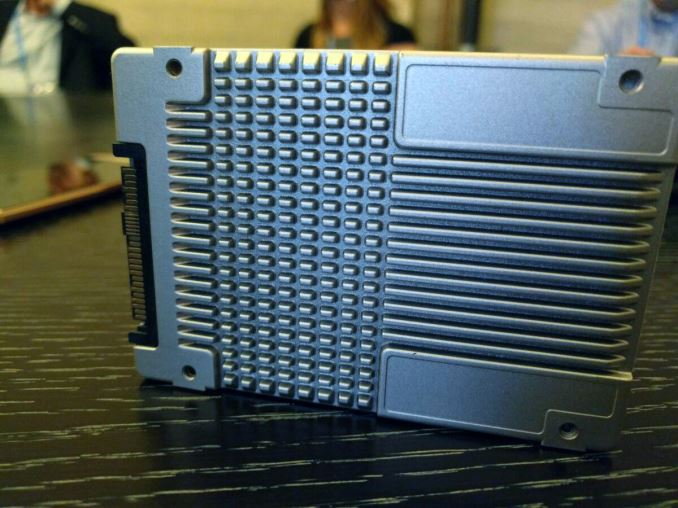Intel Rolls Out New PCIe SSDs for Cloud Datacenters
by Billy Tallis & Anton Shilov on March 31, 2016 8:00 PM EST
Intel on Thursday introduced several new PCIe SSDs designed for cloud datacenters. The new drives increase capacities, shrink latencies and offer higher throughput in order to follow demands of new datacenters deployed by various companies these days. Some of the new SSDs are based on Intel’s 3D NAND memory, whereas other feature NVMe 1.2 technology and dual-port U.2 capability to increase performance of mission-critical data-storage applications.
Intel hopes that in the future SSDs will be used not only to store hot, frequently used data, but also data that is currently stored on highly-reliable high-performance hard drives. To replace 10K and 15K RPM HDDs in the datacenter, Intel needs to offer improved reliability, high endurance, unbeatable performance, lower costs and additional features impossible on HDDs. The new SSDs from the company bring a number of improvements to the datacenter compared to previous-generation drives.
The new Intel SSD DC P3320 and P3520 families of SSDs are based on 32-layer 3D NAND flash memory developed and produced by Intel and Micron. The drives are powered by unspecified controllers, and support end-to-end data protection as well as some other functions important in the datacenters. Intel claims that that its 3D NAND has better endurance than planar NAND flash memory, which is common knowledge at this point, but does not provide any exact numbers for their NAND. The DC P3320 comes in 2.5” or HHHL card form-factor and uses either PCIe 3.0 x4 or U.2 to connect to the host. The DC P3320 is being pitched as a step up from Intel's SATA-based datacenter SSDs, while the DC P3520 will presumably be replacing the DC P3500 series.
| Specifications of Intel DC P3320 SSDs | ||||
| 450 GB | 1.2 TB | 2 TB | ||
| Form Factor | 2.5" drive | 2.5" drive/HHHL card | ||
| Controller | unknown | |||
| Interface | U.2 | U.2 or PCIe 3.0 x4 | ||
| Protocol | NVMe | |||
| DRAM | unknown | |||
| NAND | 256 Gb MLC 32-layer 3D NAND |
256 Gb MLC 32-layer 3D NAND |
256 Gb MLC 32-layer 3D NAND |
|
| Sequential Read | 1100 MB/s | 1600 MB/s | 1600 MB/s | |
| Sequential Write | 500 MB/s | 1000 MB/s | 1400 MB/s | |
| 4KB Random Read (QD32) | 130K IOPS | 275K IOPS | 365K IOPS | |
| 4KB Random Write (QD32) | 17K IOPS | 22K IOPS | 22K IOPS | |
| Launch Date | Q1 2016 | |||
The DC P3320 SSDs offer a range of capacities, including 450 GB, 1.2 TB and 2 TB models and are designed for read-intensive applications. The new drives are rated to offer maximum sequential read/write speed of up to 1600/1400 MB/s. Maximum random 4K read/write speed declared by Intel for the DC P3320 is 365K/22K IOPS (input/output operations per second). Intel does not reveal any details about the DC P3520, but claims that these drives were designed to deliver “significant” performance and latency improvements over the DC P3320 (which probably indicates higher parallelism and higher capacities, which Intel does not want to talk about at the moment).
Meanwhile the new Intel DC D3600/3700 SSDs (not to be confused with the P or S series) are designed for mission-critical storage applications that should function 24/7, which is why they utilize proven MLC NAND flash memory with high-endurance technology (HET) as well as controllers that support NVMe 1.2 technology with various high-availability features and support for up to 80 I/O queues. Intel does not disclose which controller it uses, but claims that they feature an integrated memory buffer and dynamic multiple namespaces management technology to improve efficiency of data management across drives in one machine, an exclusive feature (which potentially means that Intel uses a custom controller for these SSDs). The drives sport an active/active dual-port design that connects through a compatible backplane to two host systems simultaneously (which enables run-time recovery during failover when one of the hosts is unavailable) and support hot-plug capability. The DC D3600/D3700 drives also feature end-to-end data protection, power-loss data protection with self-test and thermal throttling and monitoring to ensure maximum reliability. The SSDs utilize PCIe 3.0 x4 interface and U.2 connectors. Since each drive has only a single U.2 connector, their dual-port mode relies on the backplane routing two PCIe lanes to each of the two host systems.
| Specifications of Intel DC D3600 and D3700 SSDs | |||||
| DC3700 800 GB | DC3600 1 TB | DC3700 1.6 TB | DC3600 2 TB | ||
| Form Factor | 2.5" drive with U.2 interface | ||||
| Controller | unknown | ||||
| Interface | U.2/PCIe 3.0 x4 | ||||
| Protocol | NVMe 1.2 | ||||
| DRAM | unknown | ||||
| NAND | MLC NAND with HET (high-endurance technology) | ||||
| Sequential Read | 1900 MB/s | 1800 MB/s | 2100 MB/s | 2100 MB/s | |
| Sequential Write | 970 MB/s | 940 MB/s | 1500 MB/s | 1500 MB/s | |
| 4KB Random Read (QD32) | 450K IOPS | 450 K IOPS | 470K IOPS | 470K IOPS | |
| 4KB Random Write (QD32) | 65K IOPS | 25K IOPS | 95K IOPS | 30K IOPS | |
| Launch Date | Q1 2016 | ||||
Intel’s DC D3600/D3700 solid-state drives will be available in 800 GB, 1.6 TB (D3700) as well as 1 TB and 2 TB (D3600) configurations. According to Intel, the new SSDs, deliver sequential read speeds of up to 2100 MB/s and sequential write performance of up to 1500 MB/s. The new SSDs can also perform up to 470K random read IOPS (4KB) and up to 95K random write IOPS (4KB).
Since SSDs with U.2 interface are not compatible with existing SAS or SATA backplanes (because they do not support PCIe), they need support from makers of storage solutions for datacenters. Intel claims that companies like EMC, Huawei, Quanta, Wistron and X-IO Technologies are ready to produce mission-critical storage ecosystem for PCIe-based SSDs, but does not provide further details.
A hands-on look at a sample of the DC D3700 revealed that Intel has changed the design of the heatsink on the bottom of the drive to allow for airflow in two directions across the back half of the drive where the controller most likely resides.
Intel did not touch upon price and availability details about its new SSDs, but expect them to arrive later this year. Keeping in mind that there are not a lot of mission-critical PCIe backplanes in the wild at the moment, it will take some time before Intel’s DC D3600/D3700 get more or less widespread.
Source: Intel













21 Comments
View All Comments
Samus - Thursday, March 31, 2016 - link
Drool. Can't wait for the consumer (a la SSD 730) model.iwod - Thursday, March 31, 2016 - link
Ok, So on a PCI-E 3.0 4x Interface the only manage to get 2GB/s. Improved Random Read....What exactly make this SSD Good when Samsung has something that is much better?
iwod - Thursday, March 31, 2016 - link
Cant Edit?? :OAnd i forgot, still 2TB only?
Billy Tallis - Friday, April 1, 2016 - link
The DC D series drives aren't going to be using 3D NAND initially, so there's no particular reason to expect a big capacity boost. The DC P3320 will eventually grow beyond 2TB, but those details haven't been announced.close - Friday, April 1, 2016 - link
As far as I can tell Samsung's only DC product at 2.5" NVMe PCIe is the PM953. It goes up to 1.92TB and the specs are 1GB/s read, 870MB/s write for the largest capacity (google MZQLV1T9HCJM).Only the PCIe cards from Samsung go up to 6TB (6GB/s read, 2GB/s write). Everything else they offer is SAS or SATA.
Or were you comparing Intel's DC SSDs to Samsung's consumer SSDs? In this case it's because you can sell anything to a consumer as long as you put a big number on the box, that you can reach only in some very specific laboratory conditions and only after you sacrifice a virgin for the speed gods. Reliability is another major difference between the two.
Otherwise you'd be pressed to ask yourself why do those guys with the datacenter constantly go for the products that have worse specs than what you can order from Amazon but many times the price...
BillyONeal - Friday, April 1, 2016 - link
Keep in mind Intel's rating here is at less than 10% variation IOP to IOP; beating the drive at 100% throughput continuously. Samsung's SM961 is rated at peak IOPs over a very short period, at least if it behaves anything like the 950 Pro. (see http://www.anandtech.com/show/9702/samsung-950-pro... and look at the IOPS graphs; and how the steady-state IOPS of Intel's 750 is around 4x what the 950 Pro manages)As a consumer drive the Samsung is probably better. As a SQL Server drive, the Intel drive is probably better. Depends on your use case.
iwod - Friday, April 1, 2016 - link
But I thought those are Random Write, Random Read doesn't seems so far off, and wouldn't in DB, higher QD gives better Random Read consistency?Samus - Saturday, April 2, 2016 - link
SQL and any server running a database (even a mail server) will have tons of tiny random writes, even in log files. The problem is since most drives don't store any user data in dram cache, and only TLC drives have an SLC "buffer" all of this random IO will wear a non-enterprise drive that lacks firmware to expect this type of environment. Enterprise drives often sacrifice a little speed by delaying buffer flushes to NAND or actually caching tiny IO data (512kb before a page write) to not hammer the NAND so much. Even Samsung has the PM841DC (or something like that) which is identical to the 840 Pro with vastly different firmware. It's also slower by like 100MB/sec!Drives that cache user data to dram cache, with the exception of many Intel drives that supposedly only use it to cache the indirection table, usually have power loss protection. Even Anandtechs review of the Intel drives suspects a little user data gets cached to DRAM though.
Kristian Vättö - Friday, April 1, 2016 - link
The SM961 is an OEM drive for the client market, so it's not comparable. Client specifications are often higher because client IO workloads are bursty, making it okay to quote maximum performance, not sustained.The drives comparable to what Intel announced yesterday are PM1725 and PM953: http://www.samsung.com/semiconductor/products/flas...
JellyRoll - Friday, April 1, 2016 - link
Aren't you an agent of Samsung now?